City guides


Cairns Travel Guide
The cosmopolitan, colourful city of Cairns, in far north Queensland, is a tourist hub and the gateway to two of the world's most awesome World Heritage Sites, the Great Barrier Reef and the 110-million-year-old Daintree Rainforest.
Cairns started life as a small fishing encampment, which received an injection of prosperity in the 19th century when gold was discovered to the north and tin and timber began to be exploited in the nearby Atherton Tablelands. The harbour and fishing operations increased in importance, and tourism arrived in the early 20th century when marlin fishing became popular, and the world discovered the delights of exploring the Great Barrier Reef.
Aided by its pleasant, warm climate, the relaxed tropical town has now become a frenzied international tourism centre, flooded with visitors most of the year, its streets lined with souvenir stores, eateries and some first class hotels. The harbour is clogged with streamlined pleasure boats, and the offshore islands bristle with resorts. To cater for tourists the city fathers have even created a man-made salt-water lagoon and sandy beach on the Esplanade to replace the original muddy swamp that crowned Trinity Bay.
To holiday in Cairns is to holiday in a city that has a mission to make tourists as happy as possible. Facilities and fun recreation opportunities are excellent, and the city is a relatively inexpensive destination. Anyone who enjoys a sunny beach holiday should travel to Cairns, where the magnificent man-made lagoon offers safe swimming all year round, the sunshine guarantees a suntan, and there are plenty of shops, restaurants and nightclubs to indulge in. A Cairns holiday is also popular among young adventure tourists, with pursuits such as scuba diving, skydiving, and ballooning on offer. And, of course, the Great Barrier Reef is just a hop and a skip away.
Things to do in Cairns
Any time of year is a good time to visit Cairns due to its tropical climate and the splendid variety of natural attractions and outdoor activities on the city's doorstep. A stay in Cairns is a dream come true for nature lovers, particularly scuba divers.
Visitors can meet some of Australia's indigenous animals such as crocodiles, red pandas and koalas at Wildlife Zone or the Cairns Tropical Zoo; ride the gondolas above a canopy of the rainforest, over magnificent waterfalls and gorges, to the village of Kuranda on the Skyrail, one of Cairns' most popular attractions; or pick out some stunning opal jewellery at Quilpie Opals.
Those keen on venturing out of the city should head straight for the coast where the Great Barrier Reef awaits avid snorkelers and scuba divers, while the verdant Daintree Rainforest, part of the oldest tropical rainforest still surviving on earth, is best explored on horseback or from the treetops. Nearby Cape Tribulation is also an outdoor enthusiasts paradise, with activities such as kayaking, snorkelling, jungle surfing and river cruising on offer. The Whitsunday Islands, of which 70 percent has been declared a national or marine park, boast the resort village of Airlie Beach and are the perfect place to relax and enjoy the picturesque surroundings.
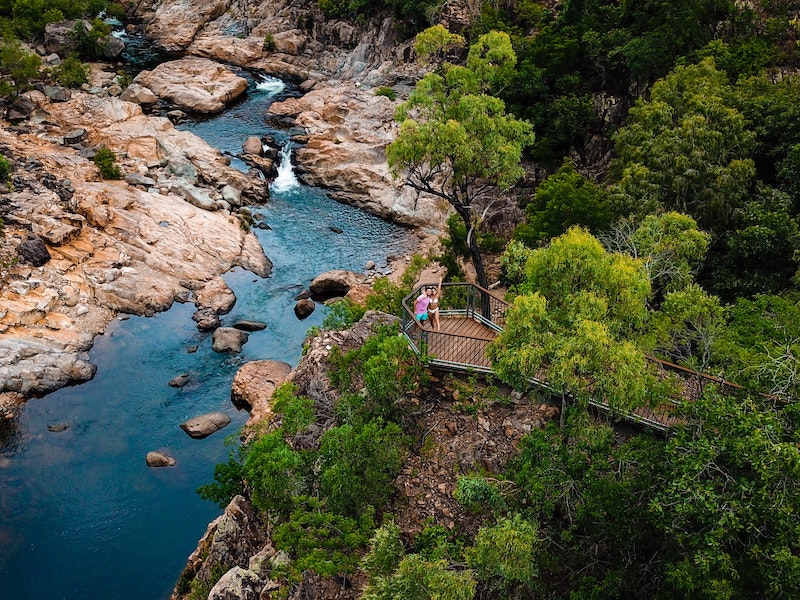
Bowling Green Bay National Park
About a six-hour drive south of Cairns lies Bowling Green Bay National Park. Covering 55,300 hectares, this is the largest National Park in the region, an area once home to the Wulgurukaba Aboriginal people who have left their mark with beautiful rock paintings. Bowling Green Bay National Park is situated between Townsville and Bowen and includes the Mount Elliot area and adjacent coastal wetlands, saltpans and mangrove swamps. Alligator Creek meanders through the park, with beautiful waterfalls and cascades crashing into deep pools, surrounded by tropical rainforest. Bowling Green Bay is a glorious place to enjoy hiking and camping and is a popular weekend excursion from Cairns.
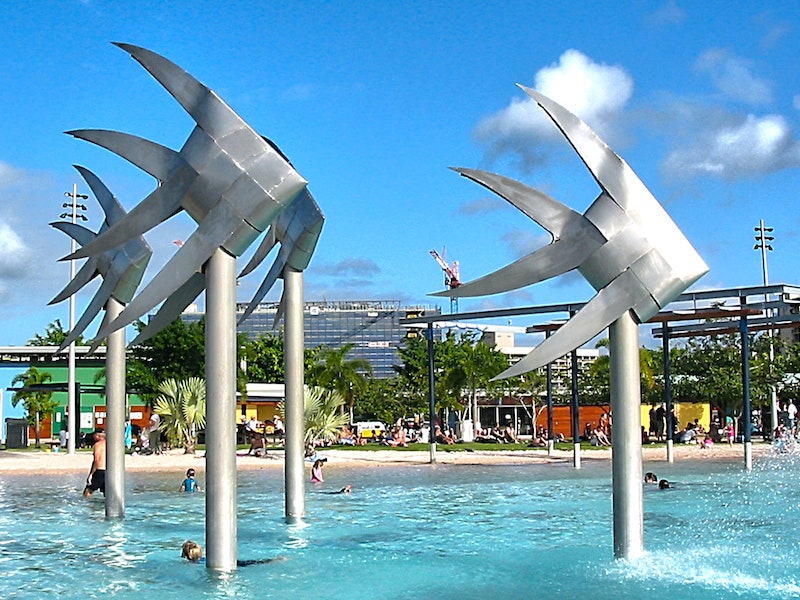
The Esplanade
The recently renovated Cairns Esplanade is the entertainment hub for visitors to the city, providing numerous recreational opportunities, and lined with a host of good restaurants, bars and cafes. Apart from a safe, sandy swimming lagoon and vast lawns used for all sorts of purposes from picnics and barbecues to kite flying, the Esplanade features wonderful Saturday arts and crafts markets, spiced up by buskers and colourful street characters. The Cairns Esplanade is also a great place to get some exercise in the city, popular with joggers and the site of a free fitness programme with classes four days a week that anybody can join. There is never a dull moment on this lively foreshore.
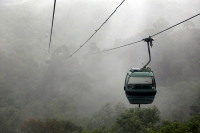
Skyrail
The most popular tourist attraction in Cairns is the Skyrail rainforest cableway, which travels nearly five miles (7.5km) from the Caravonica Terminal, the gondolas gliding above the canopy of the rainforest over magnificent waterfalls and lush gorges, to the village of Kuranda. En route passengers can alight temporarily at two stations to explore the boardwalks that have been constructed in the heart of the forest. Interpretative centres have been set up so visitors can learn about the ecology, fauna and flora of the fascinating ancient rainforest. The return journey takes about two and a half hours, and the gondolas seat up to six people. Booking in advance is advisable.
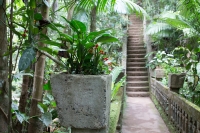
Paronella Park
Magical Paronella Park was the imaginative brainchild of a young entrepreneur, Jose Paronella, who built his dream castle on this site near Mena Creek, about 75 miles (120km) south of Cairns, in 1929. Since then the castle has come to be regarded as an architectural marvel, and a top tourist attraction, which has been used as a set for several movies. The picturesque grounds, overlooking Mena Creek Falls, feature interesting forest walks, bamboo gardens, a secret garden and a 'tunnel of love'. Cultural performances and guided walks are offered to visitors as part of the admission price. In 1997, Paronella Park was recognised as a historical treasure and listed by the National Trust. It is a popular venue for romantic events such as weddings and consistently delights visitors.
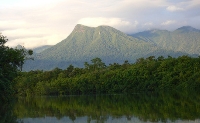
The Wet Tropics of Queensland
The Wet Tropics of Queensland is said to be the oldest tropical rainforest still surviving on earth, and is a UNESCO-listed site containing the highest number of rare or threatened plant and animal species on the planet. It also has 13 different types of rainforest and 29 species of mangrove. Among the national parks included in the Wet Tropics are Barron Gorge National Park, Black Mountain National Park, Cedar Bay National Park, Daintree National Park, Girringun National Park and Wooroonooran National Park.
This unique area covers around 745 miles (1,200km) of northern Queensland, and is visited by droves of tourists, who access it usually from Cairns, via Daintree Village. Visitors will enjoy an unrivalled natural experience, from the beautiful golden beaches to hiking through ancient forest ecosystems full of gorgeous birds, primitive flowering plants, and fascinating animals such as the estuarine crocodile. Daintree is about two hours north of Cairns, on the Captain Cook Highway, making it easily accessible for excursions and weekend getaways.
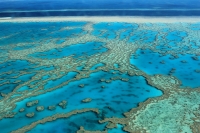
Great Barrier Reef
One of the great natural wonders of the world, the Great Barrier Reef is as big as the total combined area of the United Kingdom and Ireland, and contains more than 1,000 islands that range from sandy mounds to rainforest isles. Divers, snorkellers and nature lovers can reach specific sites by air or by water taxi. Non-divers can view this underwater world from a glass-bottomed boat.
The Reef ecosystem has evolved over hundreds of thousands of years to give life to almost 7,000 species of plants and animals. It is home to some endangered species such as the green loggerhead turtle, and is a breeding site for humpback whales. Visitors can either cruise the islands or make a base in Cairns or one of the many seaside towns along the Queensland coast. Visitors can access the Great Barrier Reef from numerous regions in Queensland, from the southern gateway of Bundaberg, Coral Coast and Country to Gladstone, Capricorn, the Whitsundays, Mackay, Townsville and Tropical North Queensland, including Cairns.
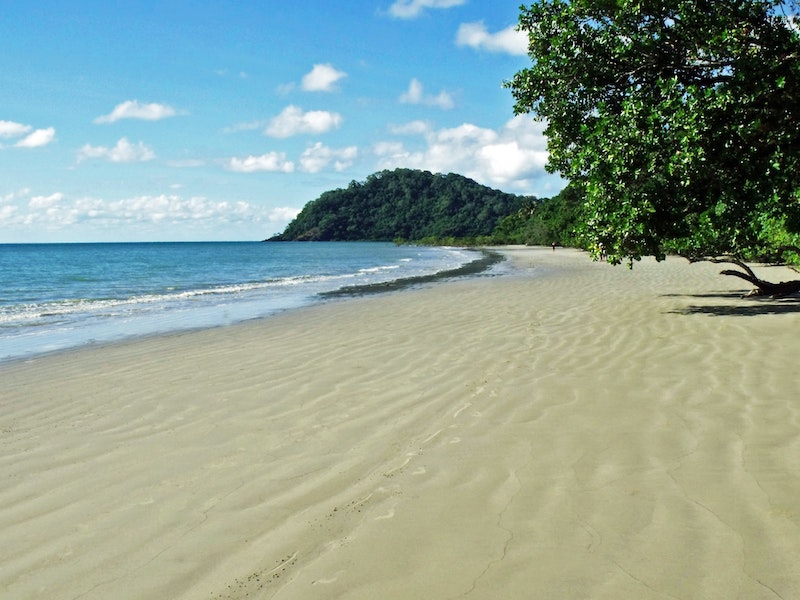
Cape Tribulation
Located within the Daintree National Park and the Wet Tropics area of Queensland, the pristine and picturesque destination of Cape Tribulation is well worth a visit while travelling through Queensland. Visitors can explore the oldest rainforest on earth from the treetops or on horesback, relax on a river cruise and spot Australia's famous crocodiles, or simply take in the marvellous scenery that abounds. The iconic Great Barrier Reef is just a short boat ride away for adventurers who desire world-class snorkelling; beach lovers will welcome strolls or horseback rides along the spectacular coast. Accommodation such as luxury resorts, self-catering cabins, bed and breakfasts and camping facilities are available.
.jpg)
Riversleigh
Australia's most famous fossil site, Riversleigh, in northwest Queensland, is a UNESCO World Heritage Site and an extension of the Lawn Hill National Park. It contains the fossil remains of ancient mammals, birds and reptiles of Oligocene and Miocene age, which were found in limestone by freshwater pools, and in caves during the period when the surrounding ecosystem was evolving from rainforest to semi-arid grassland. Most of what is known about the evolution of Australian mammals in the last 30-million years comes from bones found at a single site in the Riversleigh fossil beds, half of which were unearthed in one hour. Species such as primitive koalas and wombats, huge crocodile and large, flightless birds, as well as a range of ancestral thylacines (Tasmanian tigers) were discovered in Riversleigh.
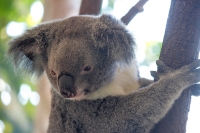
Cairns Zoom and Wildlife Dome
This spectacular attraction is enclosed by a 65-foot (20m) high glass dome on top of Cairns' iconic Reef Hotel Casino and offers exhibits and shows featuring of some of Australia's most exotic and fascinating animals. Here visitors can learn more about these unique creatures and get a fabulous introduction to the Wet Tropics Rainforest area around Cairns, preparing them for all the close-up encounters they may have with the indigenous wildlife. In this rainforest environment visitors can experience the thrill of birds such as parrots, cockatoos, lorikeets, doves and rosellas swooping freely overhead and come face-to-face with the adorable rainforest wallabies. Of course, the fact that the wildlife experience is housed in a giant dome makes this attraction wonderful no matter what the weather.
Getting Around
Central Cairns is compact enough to explore on foot. Visitors tend to congregate around the Esplanade and city centre, where there are plenty of taxis and bus stops. The public buses cover most areas with reasonable fares, though visitors should note that bus services are less frequent at night and over weekends. The city's Sunbuses run from a central transit terminal and maps and timetables are freely available from hotels and other tourist establishments. Metered taxis operate day and night from ranks throughout the city, or can be flagged down in the street. Car hire firms are plentiful for those wishing to explore further afield. Naturally, boat rides and cruises are also a popular transport option in Cairns.
Cairns Climate and Weather
Cairns has a tropical climate with little distinction between the seasons. Temperatures are warm to hot all year round, with the occasional cold snap during June and July. The rainy season is between November and May, characterised by sudden heavy falls and occasional tropical cyclones. Generally though, blue skies, sunshine, gentle breezes and pleasantly warm temperatures are the order of the day.
Australia travel info
Electricity
Electrical current is 230 volts, 50Hz. Three-pin flat blade plugs are used but are different to those in most other countries, so an adapter is normally required.
Language
English is the official language of Australia.
Money
The unit of currency is the Australian dollar (AUD), which is divided into 100 cents. Credit cards are widely accepted and ATMs are freely available throughout the country. Banks and bureaux de change exchange most foreign currencies. Banking hours are generally 9.30am to 4pm, Monday to Thursday, and 9.30am to 5pm on Friday, but some banks offer extended hours and some are open on Saturday mornings.
Tipping
Most service providers in Sydney don't expect a tip, so travellers shouldn't feel pressured into giving one. A tip of 10 percent is standard in restaurants, however, and passengers usually round up to the nearest dollar or more in taxis.
Health
A yellow fever vaccination certificate is required by travellers over one year of age arriving within six days of having stayed overnight or longer in an infected country. No other special immunisations or medications are required for most trips to Australia; however, insect repellents are strongly advised because of the risk of mosquito-borne illnesses. Another health risk is sunburn, and visitors are advised to take precautions. Medical services are excellent but can be expensive, so travellers should ensure that they have adequate insurance. Australia has a reciprocal health agreement with the United Kingdom providing for free hospital emergency medical treatment; proof of UK residence is required.
Safety
The crime rate in Australia is low; however, travellers should be aware that tourists could be targeted by petty criminals. Visitors should be vigilant about personal possessions and travel documents, particularly in popular tourist destinations such as along the Gold Coast. Tropical cyclones normally occur between November and April in some parts of Australia, particularly in Western Australia, Queensland and the Northern Territory. There is a serious risk of bush fires in summer (November to March), especially in Victoria, Tasmania, New South Wales and ACT. Also during the summer months, the shallow coastal waters of northern Australia and Queensland become infested with marine stingers, commonly known as box jellyfish, whose sting is highly dangerous and can be deadly. Visitors should pay attention to signs on beaches and follow the instructions of local lifeguards to avoid injury.
Local customs
Generally an informal attitude, in dress and behaviour, prevails in most social and business situations. Sport, particularly rugby and cricket, is almost a religion in Australia.
Doing business
Those doing business in Australia are sure to find that the friendly yet professional corporate atmosphere of the country will provide them with an exciting opportunity to develop their careers. The business culture of Australia is a bit of a hybrid breed, incorporating the trappings of British formality and conservatism, the egalitarian ethos of Scandinavian countries, and the dynamic, innovative approach to business that is generally thought of as American in origin - rounded out, of course, with typical Australian warmth and humour. The approach to management in Australia is consultative, pragmatic, and strictly non-hierarchical. Those in positions of relative power are accorded respect by virtue of their personal qualities, not simply because they happen to be the boss.
Business etiquette in Australia further reflects this egalitarian ethos. Business people should use titles initially, though they will almost certainly be told to dispense with them and refer to their colleagues by their first names. They should maintain eye contact when speaking to their associates, as this is regarded as a sign of forthrightness and trustworthiness, qualities that Australian business people tend to favour over showiness, self-aggrandisement or empty promises. Business meetings in Australia should be scheduled about a week in advance, and then confirmed a few days before they are due to take place.
Colleagues should be punctual, as lateness can be seen as a symptom of flakiness or indifference. Business meetings in Australia do not generally proceed from a set agenda. Rather, they are viewed as open forums, in which ideas are to be debated and discussed. In fact, over-preparing for a meeting can make participants seem pushy, as though they wish to bully others into adopting their opinions on the issue at hand. The dress code for business in Australia remains surprisingly traditional: dark suits and ties are the norm for men; for women, business suits, worn either with pants or a skirt. As a general rule, business people should avoid loud jewellery and accessories, as to Australian eyes they might make them seem arrogant. The official language of business in Australia is English, and business hours are generally from 8.30am (or 9am) to 5pm (or 5.30pm), Monday to Friday.
Duty free
Travellers to Australia over 18 years do not have to pay customs duty on 2.25 litres of alcohol; and 25 cigarettes or 25g of cigars or tobacco products. All tobacco products in travellers' baggage are included in this category, regardless of where they were purchased. Gifts are included in the A$900 duty-free allowance. Fresh produce and animal or plant products are prohibited.
Communications
The international dialling code for Australia is +61. Hotels, cafes and restaurants offering free WiFi are widely available; purchasing a local prepaid SIM card can be a cheaper option than paying international roaming costs, which can be quite high.
Passport & Visa
A valid passport and a visa or ETA is required for travel to Australia. An ETA is an electronically issued and verified visa, not visible in a passport. ETAs are issued to passengers travelling for touristic or business purposes. Tourist ETAs are usually valid for three months. ETAs are obtainable online at: www.eta.immi.gov.au or through most travel agents. It is highly recommended that passports are valid six months after departure from a holiday destination.
Entry requirements
US nationals must have a valid passport on arrival. A pre-obtained Electronic Travel Authority (ETA) is required for stays of up to three months.
UK nationals must have a passport valid for intended period of stay. A pre-arranged Electronic Travel Authority (ETA) is required for stays of up to three months.
Canadian nationals require a passport valid for intended period of stay. A pre-arranged Electronic Travel Authority (ETA) is required for stays of up to three months.
South African nationals must have a passport valid for at least six months after their date of departure. A visa is required.
Irish nationals must have a passport that is valid on arrival. A pre-arranged Electronic Travel Authority (ETA) is required for stays up to three months.
New Zealanders require a valid passport on entry to Australia. A Special Category Visa (SCV) is issued on arrival after completing a passenger card.
Useful contacts
Australian Tourist Commission, Sydney: +61 (0)2 9360 1111 or www.australia.com
Emergencies: 000 (112 on cellphones)Embassies / consulates in other countries
Embassy of Australia, Washington DC, United States: +1 202 797 3000.
Australian High Commission, London, United Kingdom: +44 (0)20 7379 4334.
Australian High Commission, Ottawa, Canada: +1 613 236 0841.
Australian High Commission, Pretoria, South Africa: +27 (0)12 423 6000.
Australian Embassy, Dublin, Ireland: +353 (0)1 664 5300.
Australian High Commission, Wellington, New Zealand: +64 (0)4 473 6411.
Embassies / consulates in Australia
Embassy of the United States, Canberra: +61 (0)2 6214 5600.
British High Commission, Canberra: +61 (0)2 6270 6666.
Canadian High Commission, Canberra: +61 (0)2 6270 4000.
South African High Commission, Canberra: +61 (0)2 6272 7300.
Embassy of Ireland, Canberra: +61 (0)2 6214 0000.
New Zealand High Commission, Canberra: +61 (0)2 6270 4211.


